#waitoreke
Text
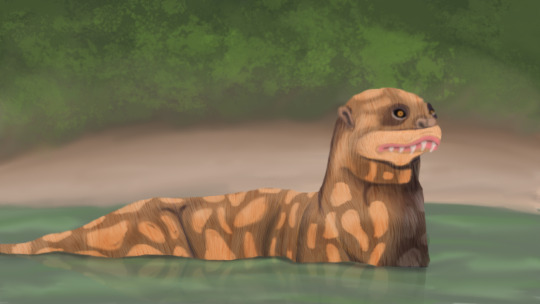
Cryptid of the Day: Waitoreke
Description: The only mammals native to New Zealand are bats, so when people claim to have seen an otter-like animal in South Island, it peaks zoological interests. The Waitoreke has been seen since the 18th century, with one of the most notable accounts coming from Captain James Cook.
70 notes
·
View notes
Text
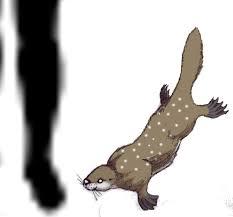
The waitoreke is an otter-like cryptid reported from New Zealand. New Zealand notably doesn't have any mammals that aren't flying (bats) or fully aquatic. Despite an alleged skin of the waitoreke being found and multiple sightings, the species still hasn't been proven to exist
20 notes
·
View notes
Text
New Zealand's lost a lot of wildlife, as colonization of a foreign land is prone to doing. It's particularly rough when a keystone species disappears; the landscape changes, communities disappear and the trophic cascade can be devastating.
This post is about the South Island waitoreke and how it built dams and lodges as reported by both Maori and English settlers
13 notes
·
View notes
Text
Miocene: Saint Bathans Fauna
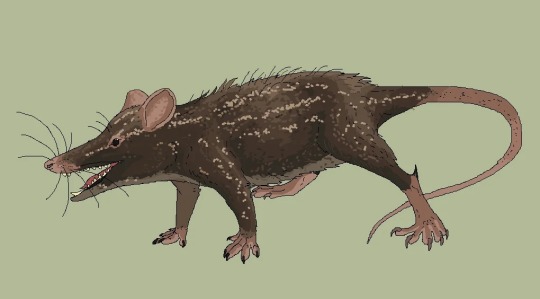
Zealanditherium worthyi by Dylan Bajda.
The non-marine fossil reccord of New Zealand is scarce. This is because through most of the Cenozoic New Zealand was underwater. However, some land must have remained, as when the fossil reccord does pick up again, we find terrestrial animals and plants that must have been vicariants.
The Miocene age Bannockburn Formation holds the so called Saint Bathans Fauna, a diversity of species dating to 19-16 million years BCE. In our timeline, this formation had leiopelmatid frogs, fish, turtles, crocodiles and an abundance of birds and bats, including representatives of iconic New Zealand groups like moas, kiwis and mystacines. The overall environment was much warmer than today’s New Zealand, the formation representing a tropical swamp environment with species not seen today in New Zealand like casuarinas.
However, notable was the presence of a non-therian mammal, of uncertain affinities. In our timeline, this was essentially the last member of an ancient lineage that clung on to the island remnants, becoming extinct as New Zealand became colder and its biota changed later in the Pliocene.
In this timeline, however, this mammal was far more sucessful, and its group, the Zealanditheres, were the dominant megafauna in the Saint Bathans fauna.
Around 45 species are known, ranging in size from small shrew like forms to heavy one ton herbivores, taking the ecological niche of the moa in our timeline. A leopard sized apex predator, Reparo whiro, dominated as the top carnivore of this assemblage. On the trees, five forms similar to opossums took the canopies, while on the ground long tailed herbivores demonstrated rabbit-like saltitation. In the waters, the otter-like Waitoreke anciens hunted for fish, alongside otter-like dagontheriid multituberculates.
Zealanditheres were of course not alone as mammals. Various flying lineages were found here, including the six-meter wingspan acamapichtliid Parirau ataroa, competing as the apex predator with Reparo and the eagle like colliform bird Tane manaakitia. The youngest deposits show tools belonging to Mazda sraosha, suggesting that these sophonts were present here in large numbers, presumably even making settlements and taking advantage of the swamps for aquaculture. Some megafaunal bones have evidence of being chopped by tools, suggetsing they hunted the local fauna. What impact this had is unclear since this is at the tail end of the formation.
Birds were still greatly represented. While the moa didn’t come to be, gracile ratites of the genus Paramoa came to resemble forms like rheas and ostriches, while kiwis are still represented by the possibly still volant Proaptery. Lithornithids and palaelodids replace the shorebirds, herons and waterfowl seen in our timeline while coliiforms are the dominant arboreal birds with no signs of raptors, passerines or parrots, showing how drastically the environmental alterations caused by the presence of multituberculates have impacted the biosphere.
On the herpetofauna, sphenodontians are more diverse and there are no lizards in sight, though otherwise it is nearly identical to our own’s.
The Saint Bathans Fauna in our world was a glimpse to a lost world, one that died as New Zealand became colder. Here, however, it remains to be seen if this unique fauna will endure, or if the climate will become colder at all.
12 notes
·
View notes
Text
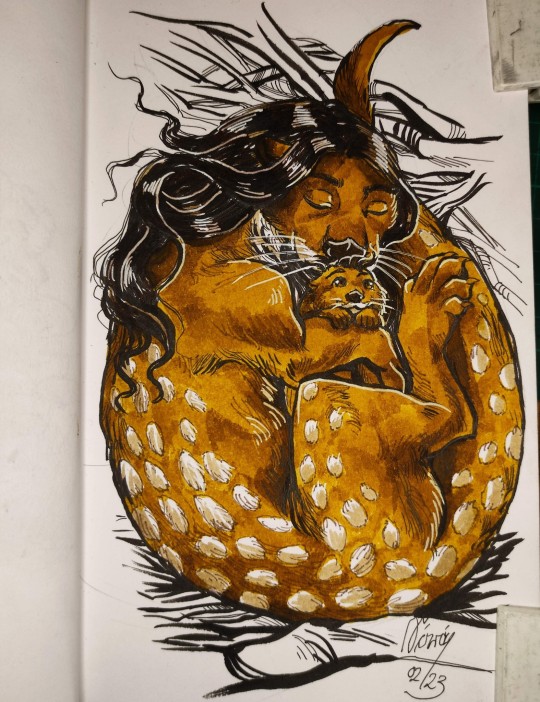
Baby Ed and his mom. I based her coat on the description of the Waitoreke a cryptid from Aotearoa (New Zealand). The Waitoreke is either described as more otterlike with white dots or having a more fox like head. This makes me theorise that it could be a semi aquatic living quoll. Otters are not native to Aotearoa, but I still wanted to at least reference it in my OFMD Otterverse.
#ofmd#ed ofmd#ofmd edward teach#ofmd fanart#our flag means death#our flag means fanart#ofmd art#ofmd otters#the otterverse#otter flag#otterart#cryptid#cryptozoology#traditional art#sketchbook#sketch#animals#animal art
11 notes
·
View notes
Photo

The Waitoreke is a New Zealand cryptid. It resembles a beaver or otter and is reported to be the size of a cat. It has been sighted periodically for over 200 years.
Possible explanations for the waitoreke are an otter, beaver, seal, or quoll. Apart from reported sightings, little to no evidence exists supporting its existence.
[source]
54 notes
·
View notes
Photo
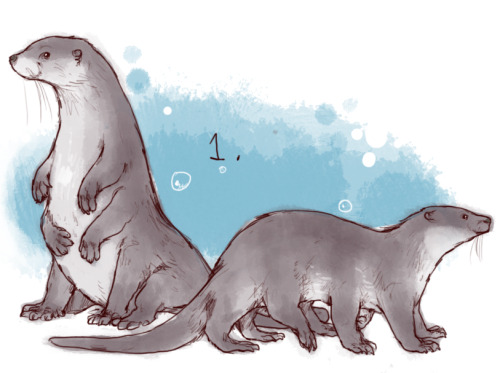
Waitoreke
An aquatic magical creature native to New Zealand, Waitoreke generally have a brown coat spotted with white, though occasional unusual coat patterns (such as the depicted grey with pale belly) are also sometimes noted. One of only a few magical monotremes, Waitoreke lay eggs and are known for their ability to switch between air and water with no difficulty as they can breathe underwater without gills, through some magical means; it is believed at present that their lungs are composed of an alchemically transfigurative interface, capable of turning water into air.
Waitoreke are eight-limbed and some believe an early specimen was born conjoined or otherwise with additional functional legs and so became successful though this theory is largely discarded and is believed to be due to similar mutations that led to wings on dragons and sphinxes. Additionally they have webbed and spurred feet, and use the spurs both for climbing and for fighting. Waitoreke vary vastly in size depending on diet as they grow. The largest specimens rival Giant Otters, the smaller, domestic house cats. Historically some Maori wixes have raised Waitoreke from the egg, and thus kept them as pets though this has never been terribly common. Like wild specimens, domesticated Waitoreke are excellent hunters and are capable of building beaver-like dams, and have been utilised for these purposes even as their wild kin may be deemed troublemakers for it.
(Image Source)
(Art is from the utterly amazing @iguanamouth/@lizardshuffle who kindly gave permission to use this image of theirs here. Read about the Waitoreke in lore Here, Here, Here, and Here. I hate that I have to include this but PLEASE DO NOT DELETE THE IMAGE SOURCE OR THE CAPTION.)
38 notes
·
View notes
Photo
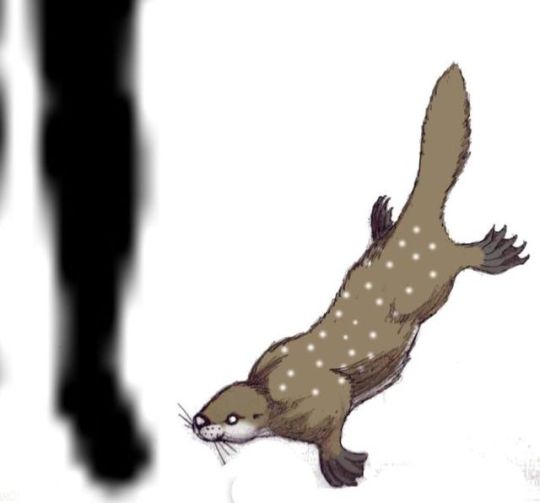
The waitoreke is an otter-like creature from the folklore of New Zealand. Described as being the size of a cat, with brown fur and short legs, it is most often seen in or near the water of New Zealand's South Island.
Several people have presented evidence of the waitoreke's existence. German geologist Julius von Haast found a spotted pelt in 1868, which was thought to belong to the waitoreke. Even the legendary explorer Captain James Cook claimed to have encountered the creature in 1772.
Image source.
Monster master list.
Suggest a spook.
110 notes
·
View notes
Note
is there a fantasy / mythology creature you wish you could have as a pet? (or if you could make up your own crazy pet, what would it be?)
OH SO VERY MANY my friend!
The cheat answer is the Dæmons from Golden Compass, so a shapeshifting animal companion you can talk to, that would be rad, BUT, if I have to pick a specific one... (not really fantasy or mythology so Ill try and do those haha)
I would love a dragon, not even to do your usual dragon stuff (I WOULD go flying though), I just think they would be wise and that i would learn a great deal.
If cryptids count, I would very much like the Waitoreke to be real, as far as I can tell its aan otter/beaver kind of little guy from New Zealand.
This is really fun to think about but I dont actually know a lot of mythological creatures??? the only other one on my mind is Direwolves, which I would also adore!!!!!
#thank you for the ask <3#i feel it is obligatory to also mention that the pokemon i would want as a pet is Spheal
1 note
·
View note
Photo
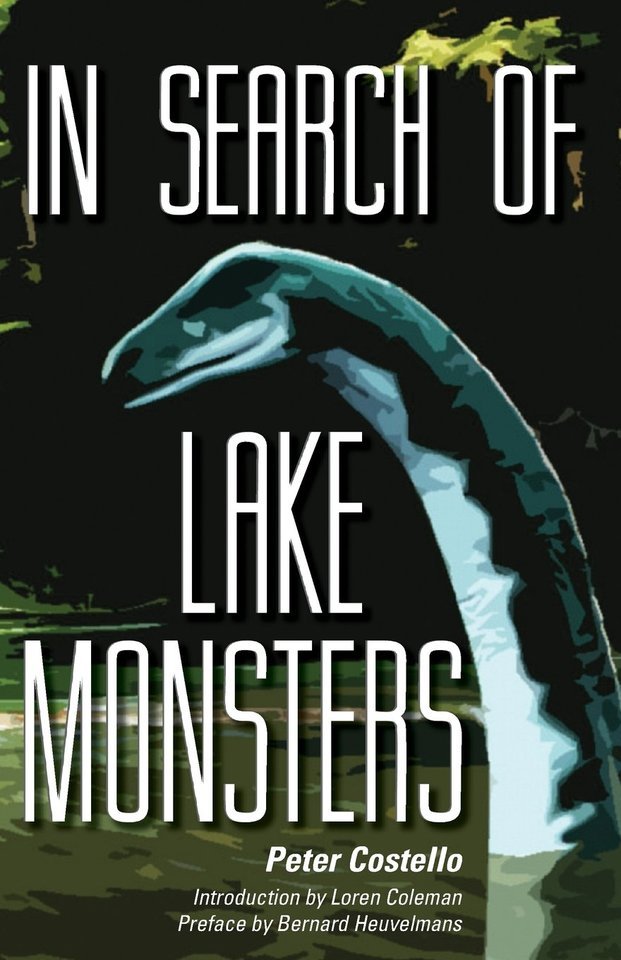

In Search of Lake Monsters was written by Peter Costello and first published in early 2015. The book highlights the most famous lake monsters, of course, like the Loch Ness Monster. However, it also features some of the more lesser known ones such as New Zealand’s Waitoreke. Costello also goes over theories for what lake monsters could possibly be.
Pick up a copy here!
60 notes
·
View notes
Photo

Cryptid of the Day: Waitoreke
Description: Are there otters, or otter like creatures on New Zealand’s South Island. Explorers from Captain Cook to Walter Mantell have claimed to see an otter like creature with white spots on its back. Maybe it was the newly introduced bushtail possum, though these sightings occurred before the species was introduced to New Zealand.
66 notes
·
View notes
Note
"#some nz otter thing that's probably a possum someone punted into the channel tbh" I'm sorry WHAT
it’s called a waitoreke! I didn’t even look at the page before, but:
“This description is strongly reminiscent of a common brushtail possum which despite being primarily arboreal sleeps in burrows or dens.“
some dude legit mistook a possum for one.
also I think it’s really cute that NZ shares a bunch of cryptids with Australia. forging bonds of friendship over shared blob monsters is the diplomacy the world needs.
#mp#asks#there are no cryptids near me where i live now!#unfair!#we do have the desert though which is suitably weird#canadianwheatpirates
4 notes
·
View notes
Text
Nonfiction: The Cryptozoologicon, Vol. 1
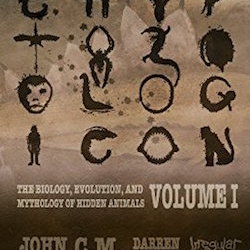
This tongue-in-cheek encyclopedia collects short articles on a number of cryptids, some famous and some not-so-famous. The authors divide each entry into three parts. (1) A description of the animal based on anecdotage and reports. (2) A skeptical explanation of the phenomenon. (3) A speculative explanation that tries to take the phenomenon seriously and fit the facts into a coherent, naturalistic explanation. The authors are skeptics, but they allow there is a great deal of fun to be had with speculative biologies and evolutionary histories, and they do their best to imagine an account that takes each cryptid at face value.
Yeti
- Description: Reddish-brown forest dwellers of the Tibetan plateau
- Skeptical take: Folklore and misinterpretations of sightings
- Speculative take: A bipedal pongine
Orang Pendek
- Description: Sasquatch-like creature of Sumatra
- Skeptical take: A mix of folklore and misinterpretation of sightings
- Speculative take: Two or more undiscovered hominids living on the same large island
Bigfoot
- Description: A seeming hybrid of man and ape
- Skeptical take: Hoaxes and folklore
- Speculative take: A bipedal pongine
Row
- Description: A sauropod capable of sitting back on its hind legs
- Skeptical take: A hoax based on a single report
- Speculative take: A long-necked tortoise of enormous size
Canvey Island Monster
- Description: Giant, bipedal, saline frog
- Skeptical take: Decayed remnant of an anglerfish
- Speculative take: A large, saline frog with rudimentary forelimbs.
De Loys's Ape
- Description: A large, ground-dwelling ape of Brazil
- Skeptical take: A hoax
- Speculative take: A large platyrrhine
Chupacabra
- Description: Feral, dog-like creature
- Skeptical take: Wild dogs, mixed with modern mythmaking and hoaxes
- Speculative take: Predatory marsupial
Waitoreke
- Description: Aquatic cat-like creature of New Zealand
- Skeptical take: An otter
- Speculative take: A one of a kind post-Miocene marsupial stranded on New Zealand
Beast of Gevaudan
- Description: A large wolf that haunted 18th century France
- Skeptical take: A plethora of unrelated sightings and attacks by wolves an dbandits.
- Speculative take: A very large mustelid (wolverine)
Bunyip
- Description: Australian "dog-faced seal"
- Skeptical take: Tall tales mixed with hoaxes
- Speculative take: A water-dwelling marsupial related to the quoll
Zuiyo Maru Creature
- Description: A carcass discovered Japanese trawler
- Skeptical take: A greatly decayed basking shark
- Speculative take: A very strange predator that lives on the bottom the sea
Mbielu-Mbielu-Mbielu
- Description: A Congolese lake dweller with plates on its back
- Skeptical take: No evidence of such a thing
- Speculative take: A very larger bicher fish
Long-Necked Seal
- Description: An aquatic animal, supposedly a seal, that resembles a plesiosaur
- Skeptical take: Sea lions
- Speculative take: A relative of sea lions that lives almost entirely submerged.
Kelpie
- Description: Carnivorous, shapeshifting horse of Scottish legend
- Skeptical take: Folklore
- Speculative take: A northern chevrotain highly adapted to aquatic environments
Dingonek
- Description: A walrus-like creature that dwells in tropical Africa
- Skeptical take: Folklore mixed with misinterpretation
- Speculative take: A sabre-tooth cat adapted to river life
Cadborosaurus
- Description: A serpentine sea monster
- Skeptical take: Misinterpretation of multiple phenomena
- Speculative take: A giant, carnivorous pinniped
Tizheruk
- Description: Semi-serpentine sea monster found off Alaska
- Skeptical take: Folklore
- Speculative take: A giant, fully aquatic member of the seal family
Hoop Snake
- Description: A snake that forms itself into a hoop and rolls over the ground.
- Skeptical take: Tall tale
- Speculative take: What can you say but accept the outlandish tale?
Megalodon
- Description: A shark of immense size, survivor of prehistoric times
- Skeptical take: Fishermen's tales
- Speculative take: Megalodon survivors, adapted to live exclusively in deep-sea environments
Ahool
- Description: A flying, bat-like monkey
- Skeptical take: Probably a hoax; possibly an unknown species of fruit bat
- Speculative take: A giant bat that occupies a very peculiar evolutionary position.
Trinity Alps Salamander
- Description: Giant salamanders native to California
- Skeptical take: Tall-tales mixed with reports of escaped Chinese salamanders
- Speculative take: A surviving population of a known giant salamander species
Goatman
- Description: A bipedal man on goat-like legs, native to the southern US
- Skeptical take: Urban myth
- Speculative take: Giant, bipedal cursorial monkeys
Mngwa
- Description: A giant, gray-coated cat
- Skeptical take: A known species of gray-coated lion
- Speculative take: A giant cat of the "golden cat" family
Minhocao
- Description: Giant snake of the Amazon jungle
- Skeptical take: Assorted animals lumped into a single classification
- Speculative take: Anaconda of stupendous size
Gambo
- Description: A marine reptile resembling a mosasaur
- Skeptical take: Only one report, of a carcass; likely a dolphin
- Speculative take: A giant, aquatic platypus
Con Rit
- Description: An armored, whale-like creature
- Skeptical take: Only one observed, a carcass; probably a partial whale carcass
- Speculative take: A giant, whale-sized prawn
Flying Rods
- Description: Cylindrical flying vertebrates (like giant centipedes) that fly fast
- Skeptical take: Insects photographed at slow shutter speeds
- Speculative take: Aerial dinocarididan survivors of the Cambrian
3 notes
·
View notes
Text
Zealanditheria: an island of misfits
(As with all animal pages so far, this only goes so far into the Miocene… for now)
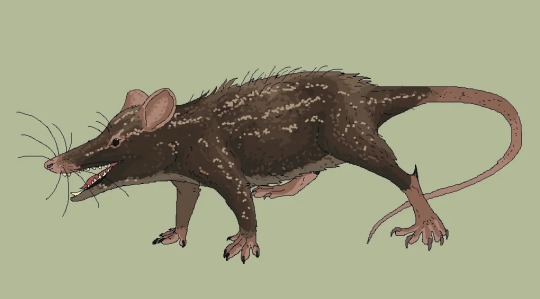
Zealanditherium worthyi by Dylan Bajda.
In our world, the Saint Bathans Fauna provided a mandible and femur belong to a non-therian mammal, on the Miocene of New Zealand. In our world, this was merely a curiosity of time, as these unique creatures did not make it past to our present. But in this timeline, they achieved dominance over the island continent of Aotearoa.
Most of their anatomy here is inferred. Like other non-therian mammals they presumably had tarsal spurs, a cloaca, a two-headed penis and epipubic bones. Therefore, this will inform how these animals are depicted in this project. What were do know from our few fossils is that they had an erect gait and proeminent incisors and canines on the lower jaw.
Because New Zealand’s terrestrial fossil reccord is restricted so far to the mid-Miocene, we’ll discuss forms from the Saint Bathans formation for now.
Around 45 species are known, ranging in size from small shrew like forms to heavy one ton herbivores, taking the ecological niche of the moa in our timeline. A leopard sized apex predator, Reparo whiro, dominated as the top carnivore of this assemblage. On the trees, five forms similar to opossums took the canopies, while on the ground long tailed herbivores demonstrated rabbit-like saltitation. In the waters, the otter-like Waitoreke anciens hunted for fish, alongside otter-like dagontheriid multituberculates.
3 notes
·
View notes
Note
Heelo I heard you had a bad night and have come to you with a question: What urban myths/cryptids are the boys of bbs most like???
Alright now you speaking my language.
Delirious is a Bigfoot/sasquatchVanoss is Owlman (and yes that is an actual cryptid)BasicallyIDoWrk is MuhuruSmii7y is the Loch Ness MonsterMoo Snuckle is MothmanOhmwrecker is JackalopeMini Ladd is the Black ShuckTerroriser is the Brosno DragonWildcat is the Beast Of ExmoorBig Jiggly Panda is BunyipDaithi is Dobhar-chúFourZer0Seven is Waitoreke
All of these were based off of their and the cryptids’ personalities, their origins, and their branding
30 notes
·
View notes
